Growth standards of infants with Prader-Willi syndrome
- PMID: 21402637
- PMCID: PMC3065075
- DOI: 10.1542/peds.2010-2736
Growth standards of infants with Prader-Willi syndrome
Abstract
Objective: To generate and report standardized growth curves for weight, length, head circumference, weight/length, and BMI for non-growth hormone-treated white infants (boys and girls) with Prader-Willi syndrome (PWS) between 0 and 36 months of age. The goal was to monitor growth and compare data with other infants with PWS.
Methods: Anthropometric measures (N = 758) were obtained according to standard methods and analyzed from 186 non-growth hormone-treated white infants (108 boys and 78 girls) with PWS between 0 and 36 months of age. Standardized growth curves were developed and the 3rd, 10th, 25th, 50th, 75th, 90th, and 97th percentiles were calculated by using the LMS (refers to λ, μ, and σ) smoothing procedure method for weight, length, head circumference, weight/length, and BMI along with the normative 50th percentile using Centers for Disease Control and Prevention national growth data from 2003. The data were plotted for comparison purposes.
Results: Five separate standardized growth curves (weight, length, head circumference, weight/length, and BMI) representing 7 percentile ranges were developed from 186 non-growth hormone-treated white male and female infants with PWS aged 0 to 36 months, and the normative 50th percentile was plotted on each standardized infant growth curve.
Conclusions: We encourage the use of these growth standards when examining infants with PWS and evaluating growth for comparison purposes, monitoring for growth patterns, nutritional assessment, and recording responses to growth hormone therapy, commonly used in infants and children with PWS.
Figures
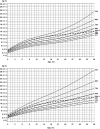
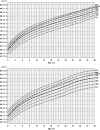
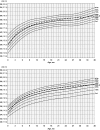
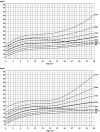
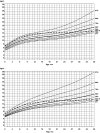
References
-
- Prader A, Labhart A, Willi H. A syndrome characterized by obesity, small stature, Cryptorchidism and oligophrenia following a myotonia-like status in infancy [in German]. Schweiz Med Wochensshr. 1956;86:1260–1261
-
- Butler MG, Lee PDK, Whitman BY. Management of Prader-Willi Syndrome. 3rd ed New York, NY: Springer; 2006
-
- Goldstone AP, Holland AJ, Hauffa BP, Hokken-Koelega AC, Tauber M. Recommendations for the diagnosis and management of Prader-Willi syndrome. J Clin Endocrinol Metab. 2008;93(11):4183–4197 - PubMed
Publication types
MeSH terms
Substances
Grants and funding
LinkOut - more resources
Full Text Sources
Medical
Molecular Biology Databases
Research Materials

